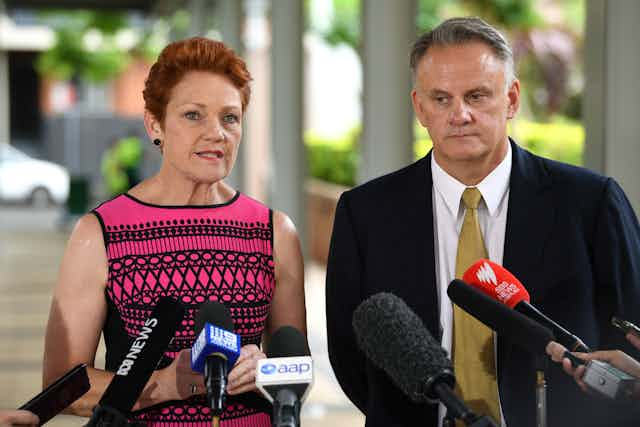Changes to the management of Pauline Hanson’s One Nation Party in NSW reaffirm an unchanging rule of politics. Opponents be damned. The fiercest fighting is reserved for colleagues.
The party’s federal leader, Hanson, confirmed her national executive’s decision to replace its NSW division and declare Latham’s position as NSW parliamentary leader vacant.
A spokesperson for Hanson said a decline in the party’s performance at the March 2023 NSW election warranted a review of the “relationship between the organisation and parliamentary wings of the party”.
Latham challenged the decision, arguing if electoral “under-performance” was the rationale for replacing the NSW executive, then Hanson should “buy a mirror”. The party’s wider fortunes are the real issue, he observed, noting recent dips in support nationally and in Queensland.
Insisting he remains the leader of the One Nation NSW parliamentary team, Latham alleges the national intervention is really about control of the party’s finances. He committed to saying more on that issue when parliament next sits.
Read more: Clive Palmer and One Nation flopped at the election. What happened?
Discord is not new to the party. ABC electoral analyst Antony Green observes of One Nation’s 35 state and federal parliamentarians over time, just “seven members have lasted long enough to face re-election”.
This latest conflict follows Hanson’s condemnation, in April, of Latham’s highly graphic social media post about independent NSW MP Alex Greenwich. Hanson labelled the post “disgusting”, asking Latham to issue an apology. He refused.
It is unlikely Latham and his One Nation parliamentary colleagues, Tania Mihailuk and Rod Roberts, will remain with the party. While their terms are assured – Latham’s expires in 2031 and his colleagues’ in 2027 – it is unclear what electoral traction they may have without Hanson’s backing.
Hanson’s return as leader ahead of the 2016 federal election proved pivotal in One Nation’s resurgence after a period of decline. However, direct support for Hanson in NSW has proven elusive, with her 2011 bid for election to the state’s upper house falling short.
Latham, on the other hand, has forged a sizeable support base in NSW. His profile was sufficient for him to resign mid-term from the Legislative Council position he secured in 2019, to successfully extend his term by eight years at the 2023 poll.
The party’s ambitions to secure lower house representation at this year’s NSW election went unfulfilled, but it did secure significant levels of support. In some seats in Sydney’s west, backing for One Nation eclipsed the Greens’ third-party status.
In Camden, One Nation attracted 13.8% of the primary vote. In Campbelltown, 11.5%. At Hawkesbury, 10.3%. In Badgerys Creek, Londonderry and Penrith, the party drew 8.2%, and in Leppington it secured 7.5%.
It was not quite a “Teal wave”, but the beginnings of third-party support that could afford One Nation strategic leverage over time. Many of these emerging subregions of support for the party overlay areas of mortgage, rental and cost-of-living stress.
While the NSW Labor government is yet to feel significant political pressure from the housing crisis and rising interest rates, a degree of negative sentiment is emerging over frustrated wage negotiations. Discontent is particularly apparent among many education, health and comparable public sector workers. A significant proportion of them reside in Sydney’s west and helped restore Labor’s electoral fortunes in a crucial battleground.
The test for Latham, Mihailuk and Roberts will be their capacity to navigate this episode of party turmoil, remain unified, and position themselves to build on proven levels of support for their brand of politics, whatever banner it falls under.
The trio have over three years to do so. It’s not an impossible task, particularly given Latham’s capacity to rally support, and the “severe challenges” predicted to constrain the upcoming NSW budget.
Complicating any scenario for Latham and co is a national leader, in Hanson, who likely shares their awareness of One Nation’s potential brand growth in one of the fastest-growing regions in Australia, and the motivation to grasp it.
If the ferocity of internal conflict is a marker of true politics, then One Nation might be about to remind us of some home truths about NSW party politics and its infamous, albeit recently becalmed, penchant for volatility.

